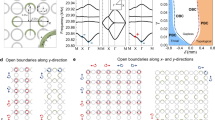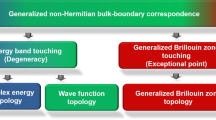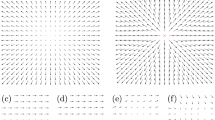Abstract
Topological modes (TMs) are usually localized at defects or boundaries of a much larger topological lattice1,2. Recent studies of non-Hermitian band theories unveiled the non-Hermitian skin effect (NHSE), by which the bulk states collapse to the boundary as skin modes3,4,5,6. Here we explore the NHSE to reshape the wavefunctions of TMs by delocalizing them from the boundary. At a critical non-Hermitian parameter, the in-gap TMs even become completely extended in the entire bulk lattice, forming an ‘extended mode outside of a continuum’. These extended modes are still protected by bulk-band topology, making them robust against local disorders. The morphing of TM wavefunction is experimentally realized in active mechanical lattices in both one-dimensional and two-dimensional topological lattices, as well as in a higher-order topological lattice. Furthermore, by the judicious engineering of the non-Hermiticity distribution, the TMs can deform into a diversity of shapes. Our findings not only broaden and deepen the current understanding of the TMs and the NHSE but also open new grounds for topological applications.
This is a preview of subscription content, access via your institution
Access options
Access Nature and 54 other Nature Portfolio journals
Get Nature+, our best-value online-access subscription
$29.99 / 30 days
cancel any time
Subscribe to this journal
Receive 51 print issues and online access
$199.00 per year
only $3.90 per issue
Buy this article
- Purchase on Springer Link
- Instant access to full article PDF
Prices may be subject to local taxes which are calculated during checkout




Similar content being viewed by others
Data availability
The data represented in Figs. 2c–e and 4c are available as Source Data. All other data that support the plots within this paper and other findings of this study are available from the corresponding authors upon reasonable request.
References
Haldane, F. D. M. Nobel Lecture: Topological quantum matter. Rev. Mod. Phys. 89, 040502 (2017).
Kosterlitz, J. M. Nobel Lecture: Topological defects and phase transitions. Rev. Mod. Phys. 89, 040501 (2017).
Yao, S. & Wang, Z. Edge states and topological invariants of non-Hermitian systems. Phys. Rev. Lett. 121, 086803 (2018).
McDonald, A., Pereg-Barnea, T. & Clerk, A. A. Phase-dependent chiral transport and effective non-Hermitian dynamics in a bosonic Kitaev-Majorana chain. Phys. Rev. X 8, 041031 (2018).
Kunst, F. K., Edvardsson, E., Budich, J. C. & Bergholtz, E. J. Biorthogonal bulk-boundary correspondence in non-Hermitian systems. Phys. Rev. Lett. 121, 026808 (2018).
Martinez Alvarez, V. M., Barrios Vargas, J. E. & Foa Torres, L. E. F. Non-Hermitian robust edge states in one dimension: anomalous localization and eigenspace condensation at exceptional points. Phys. Rev. B 97, 121401 (2018).
Ozawa, T. et al. Topological photonics. Rev. Mod. Phys. 91, 015006 (2019).
Ma, G., Xiao, M. & Chan, C. T. Topological phases in acoustic and mechanical systems. Nat. Rev. Phys. 1, 281–294 (2019).
Hafezi, M., Demler, E. A., Lukin, M. D. & Taylor, J. M. Robust optical delay lines with topological protection. Nat. Phys. 7, 907–912 (2011).
Xu, C., Chen, Z.-G., Zhang, G., Ma, G. & Wu, Y. Multi-dimensional wave steering with higher-order topological phononic crystal. Sci. Bull. 66, 1740–1745 (2021).
Hu, B. et al. Non-Hermitian topological whispering gallery. Nature 597, 655–659 (2021).
St-Jean, P. et al. Lasing in topological edge states of a one-dimensional lattice. Nat. Photonics 11, 651–656 (2017).
Harari, G. et al. Topological insulator laser: theory. Science 359, eaar4003 (2018).
Bandres, M. A. et al. Topological insulator laser: experiments. Science 359, eaar4005 (2018).
Zeng, Y. et al. Electrically pumped topological laser with valley edge modes. Nature 578, 246–250 (2020).
Barik, S. et al. A topological quantum optics interface. Science 359, 666–668 (2018).
Blanco-Redondo, A., Bell, B., Oren, D., Eggleton, B. J. & Segev, M. Topological protection of biphoton states. Science 362, 568–571 (2018).
Mittal, S., Goldschmidt, E. A. & Hafezi, M. A topological source of quantum light. Nature 561, 502–506 (2018).
Bender, C. M. Making sense of non-Hermitian Hamiltonians. Rep. Prog. Phys. 70, 947–1018 (2007).
Özdemir, Ş. K., Rotter, S., Nori, F. & Yang, L. Parity–time symmetry and exceptional points in photonics. Nat. Mater. 18, 783–798 (2019).
Miri, M.-A. & Alù, A. Exceptional points in optics and photonics. Science 363, eaar7709 (2019).
Wang, K. et al. Generating arbitrary topological windings of a non-Hermitian band. Science 371, 1240–1245 (2021).
Wang, K., Dutt, A., Wojcik, C. C. & Fan, S. Topological complex-energy braiding of non-Hermitian bands. Nature 598, 59–64 (2021).
Gao, T. et al. Observation of non-Hermitian degeneracies in a chaotic exciton-polariton billiard. Nature 526, 554–558 (2015).
Zhong, Q., Khajavikhan, M., Christodoulides, D. N. & El-Ganainy, R. Winding around non-Hermitian singularities. Nat. Commun. 9, 4808 (2018).
Tang, W. et al. Exceptional nexus with a hybrid topological invariant. Science 370, 1077–1080 (2020).
Tang, W., Ding, K. & Ma, G. Direct measurement of topological properties of an exceptional parabola. Phys. Rev. Lett. 127, 034301 (2021).
Tang, W., Ding, K. & Ma, G. Experimental realization of non-Abelian permutations in a three-state non-Hermitian system. Preprint at https://doi.org/10.48550/arXiv.2112.00982 (2022).
Ghatak, A., Brandenbourger, M., van Wezel, J. & Coulais, C. Observation of non-Hermitian topology and its bulk–edge correspondence in an active mechanical metamaterial. Proc. Natl Acad. Sci. USA 117, 29561–29568 (2020).
Zhang, L. et al. Acoustic non-Hermitian skin effect from twisted winding topology. Nat. Commun. 12, 6297 (2021).
Weidemann, S. et al. Topological funneling of light. Science 368, 311–314 (2020).
Xiao, L. et al. Non-Hermitian bulk–boundary correspondence in quantum dynamics. Nat. Phys. 16, 761–766 (2020).
Song, F., Yao, S. & Wang, Z. Non-Hermitian topological invariants in real space. Phys. Rev. Lett. 123, 246801 (2019).
Longhi, S. Probing non-Hermitian skin effect and non-Bloch phase transitions. Phys. Rev. Res. 1, 023013 (2019).
Gao, P., Willatzen, M. & Christensen, J. Anomalous topological edge states in non-Hermitian piezophononic media. Phys. Rev. Lett. 125, 206402 (2020).
Zhu, W., Teo, W. X., Li, L. & Gong, J. Delocalization of topological edge states. Phys. Rev. B 103, 195414 (2021).
Brandenbourger, M., Locsin, X., Lerner, E. & Coulais, C. Non-reciprocal robotic metamaterials. Nat. Commun. 10, 4608 (2019).
Hsu, C. W., Zhen, B., Stone, A. D., Joannopoulos, J. D. & Soljačić, M. Bound states in the continuum. Nat. Rev. Mater. 1, 16048 (2016).
Okuma, N., Kawabata, K., Shiozaki, K. & Sato, M. Topological origin of non-Hermitian skin effects. Phys. Rev. Lett. 124, 086801 (2020).
Zhang, K., Yang, Z. & Fang, C. Correspondence between winding numbers and skin modes in non-Hermitian systems. Phys. Rev. Lett. 125, 126402 (2020).
Xiao, L. et al. Observation of non-Bloch parity-time symmetry and exceptional points. Phys. Rev. Lett. 126, 230402 (2021).
Sounas, D. L. & Alù, A. Non-reciprocal photonics based on time modulation. Nat. Photonics 11, 774–783 (2017).
Nassar, H. et al. Nonreciprocity in acoustic and elastic materials. Nat. Rev. Mater. 5, 667–685 (2020).
Painter, O. et al. Two-dimensional photonic band-gap defect mode laser. Science 284, 1819–1821 (1999).
Hirose, K. et al. Watt-class high-power, high-beam-quality photonic-crystal lasers. Nat. Photonics 8, 406–411 (2014).
Zhang, W. et al. Low-threshold topological nanolasers based on the second-order corner state. Light: Sci. Appl. 9, 109 (2020).
Teo, W. X., Zhu, W. & Gong, J. Tunable two-dimensional laser arrays with zero-phase locking. Phys. Rev. B 105, L201402 (2022).
Zhao, H. et al. Topological hybrid silicon microlasers. Nat. Commun. 9, 981 (2018).
Kim, H.-R. et al. Multipolar lasing modes from topological corner states. Nat. Commun. 11, 5758 (2020).
Shao, Z.-K. et al. A high-performance topological bulk laser based on band-inversion-induced reflection. Nat. Nanotechnol. 15, 67–72 (2020).
Fan, S., Suh, W. & Joannopoulos, J. D. Temporal coupled-mode theory for the Fano resonance in optical resonators. J. Opt. Soc. Am. A 20, 569 (2003).
Chong, Y. D., Ge, L., Cao, H. & Stone, A. D. Coherent perfect absorbers: time-reversed lasers. Phys. Rev. Lett. 105, 053901 (2010).
Acknowledgements
We thank C. T. Chan, Z.-Q. Zhang, K. Ding and R.-Y. Zhang for discussions, and Q. Wang for assisting with the experiments. This work was supported by the National Natural Science Foundation of China (grant no. 11922416) and the Hong Kong Research Grants Council (grant nos. 12302420, 12300419, and C6013-18G).
Author information
Authors and Affiliations
Contributions
W.W. developed the theory and performed numerical calculations. X.W. developed the experimental platform. W.W. and G.M. designed the experimental systems. W.W. and X.W. carried out the measurements. All authors analysed the results. W.W. and G.M. wrote the manuscript. G.M. led the research
Corresponding author
Ethics declarations
Competing interests
The authors declare no competing interests.
Peer review
Peer review information
Nature thanks Corentin Coulais, Evelyn Tang and Zhong Wang for their contribution to the peer review of this work. Peer reviewer reports are available.
Additional information
Publisher’s note Springer Nature remains neutral with regard to jurisdictional claims in published maps and institutional affiliations.
Extended data figures and tables
Extended Data Fig. 1 Lasing effect of the extended TZM.
a, b, The real (a) and imaginary (b) part of the energy spectra of a nine-site NH-SSH chain (Supplementary Fig. 2a). We set \(\gamma =0.01\), \(g=0.018\). c, The evolution of the instantaneous total intensity \({I}_{{\rm{t}}{\rm{o}}{\rm{t}}}(t)\) in the chain with \({\delta }_{x}={\delta }_{{xc}}\) and \({\delta }_{x}=0\). In the calculation, we set \({I}_{{\rm{s}}{\rm{a}}{\rm{t}}}=10\). An initial field with random complex amplitudes of 0.01\(\left(m+{ni}\right)\) with \(m,n\in \left(-\mathrm{1,1}\right)\) at each site is applied. d, The steady-state intensity distribution. e, \({I}_{{\rm{t}}{\rm{o}}{\rm{t}}}^{{\rm{s}}}\) as a function of \(g\). f, \({I}_{{\rm{t}}{\rm{o}}{\rm{t}}}^{{\rm{s}}}\) as a function of the lattice size (total site number \(N\)).
Extended Data Fig. 2 Scattering coefficients of the TZM in a nine-site NH-SSH chain.
a, b, The scattering coefficients \(\left|{S}_{i1}\right|\) with \({\delta }_{x}={\delta }_{{xc}}\) (a) and \({\delta }_{x}=0\) (b), pumped at site 1, as a function of \(\Delta f=f-{f}_{{TZM}}\), where \({f}_{{\rm{T}}{\rm{Z}}{\rm{M}}}\) is the TZM’s eigenfrequency and \(f\) is the pumping frequency.
Extended Data Fig. 3 Scattering coefficients of a non-Hermitian topological quadrupole insulator.
The scattering coefficients \(\left|{S}_{1}^{{ij}}\right|\) [with \(\left(i,{j}\right)\) indexing all the lattice sites] of a non-Hermitian topological quadrupole insulator, pumped at the left-most corner, as a function of \(\Delta f=f-{f}_{{\rm{T}}{\rm{C}}{\rm{M}}}\), where \({f}_{{\rm{T}}{\rm{Z}}{\rm{M}}}\) is the TCM’s eigenfrequency, and \(f\) is the pumping frequency.
Extended Data Fig. 4 A coherent beam splitter based on the delocalized TMs.
a, A coherent topological beam splitter. All red (blue) ports can send out coherent waves. b, The schematic model of a topological interface (similar to the one shown in Fig. 1d) stacked along \(y\) direction. Here, the right part is also non-Hermitian with a biased hopping \({\delta }_{x{\rm{R}}}(y)\) toward the right end. c, The real part of the response field (middle panel) with \({\delta }_{x{\rm{L}}}\) and \({\delta }_{x{\rm{R}}}\) taking the profiles in the left and right panels, respectively. Clearly, all the red (blue) sites are in-phase with each other. The increase in the amplitudes at the outputs is also due to the NHSE, which injects energy into the system. d, The real part of the response field with \({\delta }_{x{\rm{L}}}={\delta }_{x{\rm{R}}}=0\).
Supplementary information
Supplementary Information
This Supplementary Information file includes 12 sections, 19 figures and 19 references.
Supplementary Video 1
The non-Hermitian skin effect in a one-dimensional topological interface system.
Supplementary Video 2
Morphing of topological edge modes in two-dimensional non-Hermitian topological lattices.
Supplementary Video 3
Delocalization of a topological corner mode by the non-Hermitian skin effect.
Source data
Rights and permissions
About this article
Cite this article
Wang, W., Wang, X. & Ma, G. Non-Hermitian morphing of topological modes. Nature 608, 50–55 (2022). https://doi.org/10.1038/s41586-022-04929-1
Received:
Accepted:
Published:
Issue Date:
DOI: https://doi.org/10.1038/s41586-022-04929-1
This article is cited by
-
Observation of continuum Landau modes in non-Hermitian electric circuits
Nature Communications (2024)
-
Non-reciprocal topological solitons in active metamaterials
Nature (2024)
-
Collective non-Hermitian skin effect: point-gap topology and the doublon-holon excitations in non-reciprocal many-body systems
Communications Physics (2024)
-
Exceptional classifications of non-Hermitian systems
Communications Physics (2024)
-
Mathematical Foundations of the Non-Hermitian Skin Effect
Archive for Rational Mechanics and Analysis (2024)
Comments
By submitting a comment you agree to abide by our Terms and Community Guidelines. If you find something abusive or that does not comply with our terms or guidelines please flag it as inappropriate.



